栖息地选择的理论与模型
动物的栖息地选择与资源利用

迁徙类型
根据迁徙距离、时间和路线,动物迁徙可分为季节性迁徙、繁殖迁徙和
觅食迁徙等类型。
02
迁徙与栖息地选择的关系
迁徙动物需要在不同季节或繁殖期选择适宜的栖息地,以满足其生存和
繁殖的需求。
03
迁徙策略
动物会采取多种策略来应对迁徙过程中的挑战,如集群迁徙、夜间迁徙
、定向迁徙等。这些策略有助于动物在迁徙过程中减少能量消耗、提高
精度。
THANKS.
适应性
物种通过进化发展出的与特定生 态环境相适应的形态、生理和行 为特征。
物种间竞争与共存
竞争排斥原则
01
具有相似生态位的物种会因竞争有限资源而相互排斥。
共存机制
02
物种通过分化生态位、形成互惠关系或利用不同资源等方式实
现共存。
栖息地选择中的物种间关系
03
物种在选择栖息地时会考虑与其他物种的竞争和共存关系,以
森林砍伐和土地利用变化
大规模的森林砍伐和土地利用变化导致许多动物失去家园,栖息地破碎化严重。
城市化进程
城市扩张和建设使得原有自然生境被道路、建筑等人工设施所替代,对动物栖息造成巨大 压力。
环境污染
工业废水、废气、固体废弃物等污染物的排放,对水域和土壤造成污染,影响动物的生存 和繁殖。
保护措施和政策建议提
建立自然保护区
通过设立自然保护区,对珍稀濒危动物及其栖息地进行就 地保护,减少人类活动的干扰。
加强法律法规建设
制定和完善相关法律法规,严厉打击非法狩猎、贩卖野生 动物及其产品的行为。
推动公众参与
加强宣传教育,提高公众对野生动物保护的意识,鼓励和 支持公众参与保护行动。
人类活动对栖息地影响评估
第四章 栖息地选择

趋性是动物根据刺激定向的一种适应性行为。 趋性是动物根据刺激定向的一种适应性行为。动物对于环境 刺激,如光线、温度、湿度、化学物质、地心引力的功能, 刺激,如光线、温度、湿度、化学物质、地心引力的功能, 有明显的趋近或避开的反应。 有明显的趋近或避开的反应。 趋性与动性不同,具有一定的方向性。 趋性与动性不同,具有一定的方向性。 趋性并不都是简单的、自动的对感觉刺激的定向运动。有时, 趋性并不都是简单的、自动的对感觉刺激的定向运动。有时, 它可能是一系列复杂的行为类型中一个构成部分, 它可能是一系列复杂的行为类型中一个构成部分,也可能是 由两个或更多个趋性现象形成的定向运动, 由两个或更多个趋性现象形成的定向运动,有的则是包含在 其它行为中的趋性部分。 其它行为中的趋性部分。
第三节
定向和导航
动物一旦确定由一个栖息地向另一个栖息地进行迁移, 动物一旦确定由一个栖息地向另一个栖息地进行迁移,随 即面临着一个在迁移过程中定向和导航的问题。 即面临着一个在迁移过程中定向和导航的问题。
பைடு நூலகம்
一、动性和趋性
小范围内(几个厘米左右) 小范围内(几个厘米左右)的定向迁移常出现在许多无脊 椎动物中,引起这种定向迁移的刺激也较明显, 椎动物中,引起这种定向迁移的刺激也较明显,如光源及 湿度的梯度变化。 湿度的梯度变化。这种小范围的定向迁移现象可分为两种 情况: 情况: 一是动物在没有方向性的运动中到达喜爱的栖息地。 一是动物在没有方向性的运动中到达喜爱的栖息地。 二是迎着或背向刺激源沿一定的角度进行迁移。 二是迎着或背向刺激源沿一定的角度进行迁移。前者称为 动性,后者称为趋性。 动性,后者称为趋性。 动性是指一连串的随机活动。 动性是指一连串的随机活动。动物通过一定的躲避或接近 运动,最后达到或避开某一刺激源。 运动,最后达到或避开某一刺激源。它们借此回避不利环 并经常使自己处于适宜于生活的区域内。 境,并经常使自己处于适宜于生活的区域内。
《栖息地的选择》教案设计
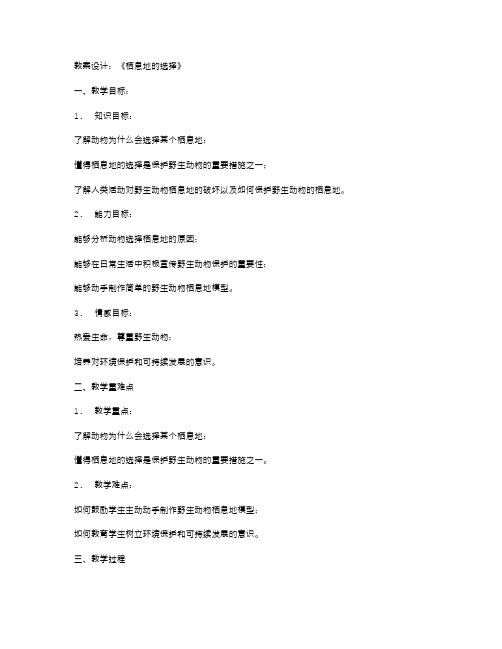
教案设计:《栖息地的选择》一、教学目标:1.知识目标:了解动物为什么会选择某个栖息地;懂得栖息地的选择是保护野生动物的重要措施之一;了解人类活动对野生动物栖息地的破坏以及如何保护野生动物的栖息地。
2.能力目标:能够分析动物选择栖息地的原因;能够在日常生活中积极宣传野生动物保护的重要性;能够动手制作简单的野生动物栖息地模型。
3.情感目标:热爱生命,尊重野生动物;培养对环境保护和可持续发展的意识。
二、教学重难点1.教学重点:了解动物为什么会选择某个栖息地;懂得栖息地的选择是保护野生动物的重要措施之一。
2.教学难点:如何鼓励学生主动动手制作野生动物栖息地模型;如何教育学生树立环境保护和可持续发展的意识。
三、教学过程1.导入:教师播放一段介绍栖息地的视频,并和学生进行讨论:你们知道动物为什么选择某个栖息地吗?什么情况下,动物可能会更换栖息地?人类活动有哪些可能对动物栖息地造成影响?2.讲解:教师对于学生的问题进行讲解,可以通过图片、视频等多种多样的手段,让学生更深入地了解动物的栖息地选择以及人类活动的影响。
3.制作栖息地模型教师引导学生动手制作一个简单的栖息地模型,根据不同的环境和栖息动物的不同特点,让学生尝试着去设计出最适合动物居住的栖息地模型。
4.学习内容再次进行讲解教师再次让学生学习一些与栖息地有关的知识点,如为什么说保护野生动物的栖息地是重要措施等。
5.团队合作教师安排学生分成小组,让他们团队合作,利用科技手段进行科学研究,如使用手机摄像头记录野生动物栖息地的生态环境等。
6.展示与分享学生的小组通过展示和分享,让大家都了解到各自团队里都有怎样的发现,或者是科学研究过程中遇到过哪些问题,还有怎么解决的等。
7.总结教师总结本节课的主要内容,让学生们能够更加明确环境保护和可持续发展的重要性,能够通过自己的切身体验来理解动物需要一个良好的栖息地,以及环保需要大家的共同努力。
四、教学手段1.播放一段栖息地的视频片段;2.打印一些有关栖息地的图片让学生观看;3.制作一些有关栖息地的模型,让学生参与制作和设计;4.学生小组以科技手段,如使用手机摄像头等来记录野生动物的栖息地生态环境等。
模糊逻辑模型建立鱼类栖息地适宜度基准
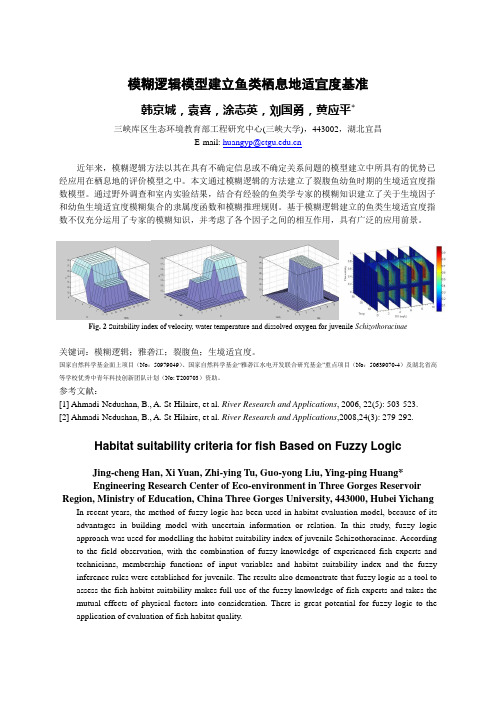
模糊逻辑模型建立鱼类栖息地适宜度基准韩京城,袁喜,涂志英,刘国勇,黄应平*三峡库区生态环境教育部工程研究中心(三峡大学),443002,湖北宜昌E-mail: huangyp@近年来,模糊逻辑方法以其在具有不确定信息或不确定关系问题的模型建立中所具有的优势已经应用在栖息地的评价模型之中。
本文通过模糊逻辑的方法建立了裂腹鱼幼鱼时期的生境适宜度指数模型。
通过野外调查和室内实验结果,结合有经验的鱼类学专家的模糊知识建立了关于生境因子和幼鱼生境适宜度模糊集合的隶属度函数和模糊推理规则。
基于模糊逻辑建立的鱼类生境适宜度指数不仅充分运用了专家的模糊知识,并考虑了各个因子之间的相互作用,具有广泛的应用前景。
Fig. 2 Suitability index of velocity, water temperature and dissolved oxygen for juvenile Schizothoracinae关键词:模糊逻辑;雅砻江;裂腹鱼;生境适宜度。
国家自然科学基金面上项目(No:50979049)、国家自然科学基金“雅砻江水电开发联合研究基金”重点项目(No:50639070-4)及湖北省高等学校优秀中青年科技创新团队计划(No: T200703)资助。
参考文献:[1] Ahmadi-Nedushan, B., A. St-Hilaire, et al. River Research and Applications, 2006, 22(5): 503-523.[2] Ahmadi-Nedushan, B., A. St-Hilaire, et al. River Research and Applications,2008,24(3): 279-292.Habitat suitability criteria for fish Based on Fuzzy LogicJing-cheng Han, Xi Yuan, Zhi-ying Tu, Guo-yong Liu, Ying-ping Huang*Engineering Research Center of Eco-environment in Three Gorges Reservoir Region, Ministry of Education, China Three Gorges University, 443000, Hubei Yichang In recent years, the method of fuzzy logic has been used in habitat evaluation model, because of its advantages in building model with uncertain information or relation. In this study, fuzzy logic approach was used for modelling the habitat suitability index of juvenile Schizothoracinae. According to the field observation, with the combination of fuzzy knowledge of experienced fish experts and technicians, membership functions of input variables and habitat suitability index and the fuzzy inference rules were established for juvenile. The results also demonstrate that fuzzy logic as a tool to assess the fish habitat suitability makes full use of the fuzzy knowledge of fish experts and takes the mutual effects of physical factors into consideration. There is great potential for fuzzy logic to the application of evaluation of fish habitat quality.。
偏微分方程模型在生态系统研究中的应用

偏微分方程模型在生态系统研究中的应用生态系统是由各种生物体及其周围环境相互作用而形成的一个动态平衡系统。
为了更好地理解和预测生态系统中的变化,科学家们通过运用数学模型来模拟和分析各种生态过程。
而偏微分方程模型作为一种强大的工具,在生态系统研究中发挥着重要作用。
一、物种扩散模型物种的扩散是生态系统中一个重要的现象,它关系到生物在空间上的分布和演化。
偏微分方程模型可以用来描述物种的扩散过程。
典型的例子是 Fisher 方程,它描述了一个物种在空间中的扩散和繁殖,可以用来预测物种在不同环境条件下的扩散速度和范围。
二、捕食者-猎物模型捕食者-猎物系统是生态系统中一个典型的相互作用模式,捕食者和猎物之间的关系影响着整个生态系统的平衡。
通过建立偏微分方程模型,可以模拟捕食者和猎物之间的数量动态变化,研究二者之间的稳定性和周期性,进而预测整个生态系统的稳定性。
三、生态位模型生态位是描述一个生物在其生态系统中所占据的生活方式和作用的概念。
通过偏微分方程模型,可以从数学上描述各个生物种群在生态位上的分布和竞争关系。
这有助于我们理解生物群落内的种群结构和相互作用,为生态保护和管理提供科学依据。
四、栖息地模型栖息地是生物生存和繁殖的场所,栖息地的变化直接影响着生物种群的数量和分布。
利用偏微分方程模型可以描述栖息地的空间变化和动态过程,预测栖息地的退化和扩展对生态系统的影响,为自然保护和栖息地恢复提供理论支持。
五、气候变化模型气候变化对生态系统的影响是全面的,从环境温度到降水量,都会直接影响生物的生长和繁殖。
通过建立偏微分方程模型,可以模拟气候变化对生态系统的影响,预测生物种群对气候变化的适应性和生态系统的稳定性,为全球变暖和生态环境保护提供科学依据。
总之,偏微分方程模型在生态系统研究中发挥着不可替代的作用,它通过数学建模的方式,帮助我们深入理解生物群落的结构与功能,预测生态系统的动态变化,为保护生物多样性和生态平衡提供科学支持。
动物栖息地概述
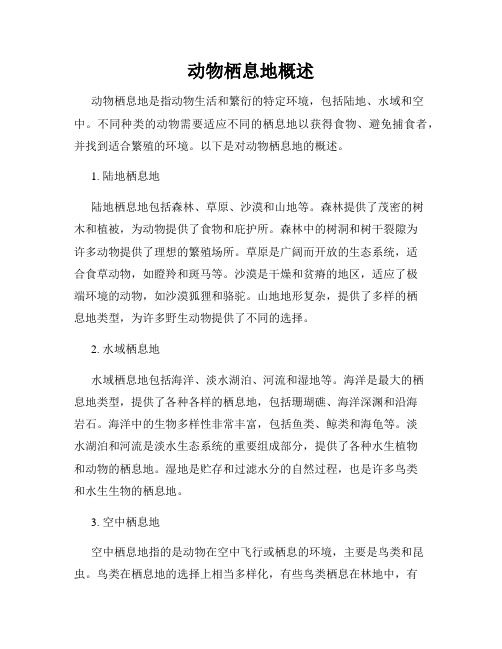
动物栖息地概述动物栖息地是指动物生活和繁衍的特定环境,包括陆地、水域和空中。
不同种类的动物需要适应不同的栖息地以获得食物、避免捕食者,并找到适合繁殖的环境。
以下是对动物栖息地的概述。
1. 陆地栖息地陆地栖息地包括森林、草原、沙漠和山地等。
森林提供了茂密的树木和植被,为动物提供了食物和庇护所。
森林中的树洞和树干裂隙为许多动物提供了理想的繁殖场所。
草原是广阔而开放的生态系统,适合食草动物,如瞪羚和斑马等。
沙漠是干燥和贫瘠的地区,适应了极端环境的动物,如沙漠狐狸和骆驼。
山地地形复杂,提供了多样的栖息地类型,为许多野生动物提供了不同的选择。
2. 水域栖息地水域栖息地包括海洋、淡水湖泊、河流和湿地等。
海洋是最大的栖息地类型,提供了各种各样的栖息地,包括珊瑚礁、海洋深渊和沿海岩石。
海洋中的生物多样性非常丰富,包括鱼类、鲸类和海龟等。
淡水湖泊和河流是淡水生态系统的重要组成部分,提供了各种水生植物和动物的栖息地。
湿地是贮存和过滤水分的自然过程,也是许多鸟类和水生生物的栖息地。
3. 空中栖息地空中栖息地指的是动物在空中飞行或栖息的环境,主要是鸟类和昆虫。
鸟类在栖息地的选择上相当多样化,有些鸟类栖息在林地中,有些则栖息在草地上。
它们通常在树上筑巢,利用枝叶提供的保护。
昆虫的空中栖息地则更加广泛,它们可以在森林、草地、水域和人类建筑物等各种环境中生活。
动物对于栖息地的依赖是其生存和繁衍的关键。
然而,由于人类活动的影响,许多栖息地正在遭受破坏和威胁。
森林砍伐、湿地干涸、水体污染和城市化等因素都对动物栖息地造成了严重影响。
因此,保护和恢复动物栖息地的措施变得尤为重要,以确保各种动物继续繁衍和生存下去。
总结:动物栖息地是动物生存和繁衍的特定环境,涵盖陆地、水域和空中。
不同的栖息地类型提供了各种栖息环境,满足了动物的食物需求和安全庇护所的需求。
保护和恢复动物栖息地是确保生物多样性和生态平衡的重要措施。
我们应该共同努力,保护动物栖息地,保护地球上每一个生物的家园。
河流生物栖息地调查及评估方法
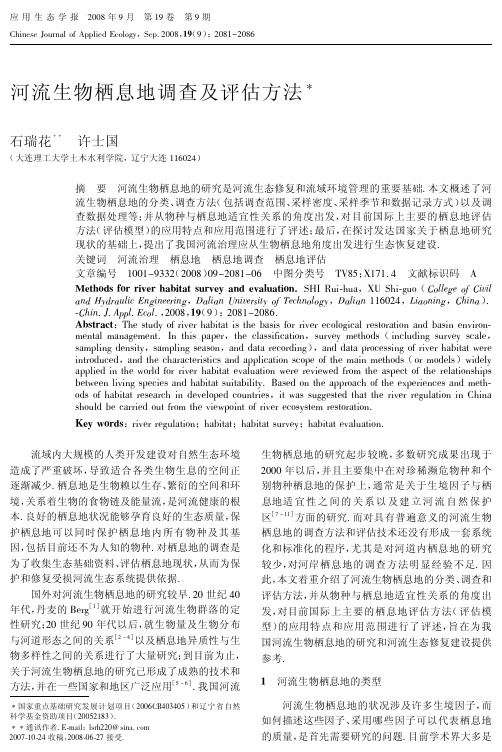
图 $" 河流生物栖息地调查范围及采样点密度 %&’( $" D$’./ (#: ,(9.) :/#,&%0 ’! %*/ ,"6B/0/: 6&B/6 *(+&%(%1
H 期! ! ! ! ! ! ! ! ! ! ! ! ! ! ! ! ! 石瑞花等: 河流生物栖息地调查及评估方法! ! ! ! ! !
河流生物栖息地调查及评估方法2083国内一般在每个监测点采国外比较有代表性的采样方法水深不超过112主要采集毛翅目蜉蝣目和广翅目等昆虫集中在堤岸边根垫和大型水生植物基部采样总采集长度约10主要采集摇蚊寡毛类蜻蜓泥蛉和甲壳类周丛生物样洗刷1015块有固着生物部分浸在水体的石块和圆木主要采集摇蚊等个体较小的底栖动物采样频率约10主要采集附着在大石块和大圆木上的毛翅目翅目摇蚊和软体动物等
3FE3
应H 用H 生H 态H 学H 报H H H H H H H
H H H H H H H H H H H H 2G 卷
将栖息地分为两种类型: 一类是生态学家定义的栖 息地单元— — —功能性栖息地 ( !"#$%&’#() *(+&%(%, ) ; 另 一类是地貌学家定义的河道内物理栖息地单元— — — 水流 生 境 ( !)’- +&’%’./, ) 或物理栖息地 ( .*0,&$() *(+&%(%) 1 功能性栖息地以河流中的介质为研究对象, 由 底质和植被类型组成1 常见的功能性栖息地种类有 无机类 ( 岩 石、 卵 石、 砾 石、 砂、 粉 砂 等) 和植物类 ( 根、 蔓生植物、 边缘植物、 落叶、 木头碎屑、 挺水植 物、 浮叶植物、 阔叶植物、 苔藓、 海藻等)
habitat quality 模块

Habitat Quality 模块介绍生物栖息地的质量是影响物种繁荣和生态系统稳定性的重要因素之一。
因此,了解并评估栖息地质量对于保护和恢复自然环境至关重要。
在本文中,我们将深入探讨栖息地质量的概念、评估方法和其对生态系统的重要性。
什么是栖息地质量栖息地质量是指一个土地区域对物种生存和繁殖的适宜程度。
它取决于很多因素,包括植被类型、土壤质量、资源可利用性等。
优质的栖息地通常具有较高的物种多样性和丰富度,并能提供丰富的食物和适宜的生存环境。
栖息地评估方法观察法观察法是最常用的栖息地评估方法之一。
通过在栖息地中观察物种的出现和数量,可以初步评估栖息地的质量。
观察法相对简单,但结果可能受到观察者技能和时间限制的影响。
模型建立模型建立是一种较为精确和复杂的栖息地评估方法。
它基于物种的生境要求和环境因素,并使用数学模型来预测栖息地质量。
模型建立可以帮助我们更全面地评估栖息地的质量,并提供决策者制定保护和管理计划的依据。
指标评估指标评估是通过测量一系列指标来评估栖息地质量。
这些指标可以包括植被覆盖率、土壤质量、水质等。
指标评估可以提供客观的数据,但需要付出一定的时间和资源成本。
栖息地质量对生态系统的重要性优质的栖息地对生态系统的维持和功能发挥起着至关重要的作用。
以下是栖息地质量对生态系统的重要性的几个方面:物种多样性维护优质的栖息地通常具有更高的物种多样性。
各种不同的物种在栖息地中找到适宜的生存条件,从而增加了物种多样性。
物种多样性对于生态系统的稳定性、种群控制和食物链平衡至关重要。
生物群落稳定性生物群落对栖息地的质量非常敏感。
恶劣的栖息地条件会导致物种灭绝或迁徙,从而破坏生物群落的稳定性。
优质的栖息地能够提供稳定的食物和适宜的生存条件,有利于维持生物群落的稳定。
生态系统功能栖息地质量直接影响生态系统的功能。
优质的栖息地能够提供一定数量和多样性的生态系统服务,例如土壤保持、空气和水质净化、气候调节等。
这些生态系统功能对于人类的生存和福祉至关重要。
动物栖息地研究
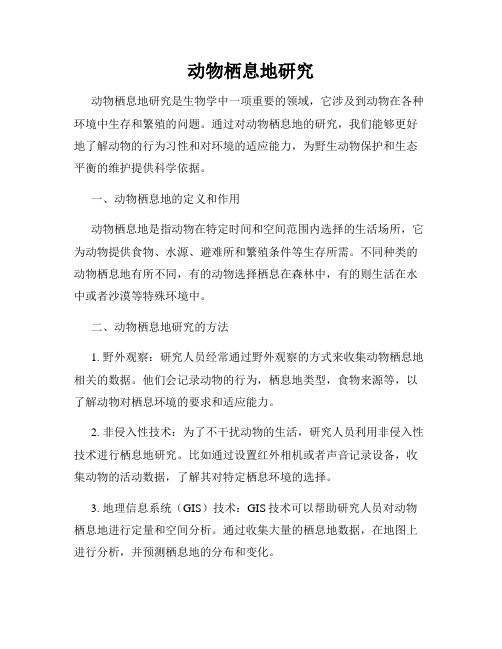
动物栖息地研究动物栖息地研究是生物学中一项重要的领域,它涉及到动物在各种环境中生存和繁殖的问题。
通过对动物栖息地的研究,我们能够更好地了解动物的行为习性和对环境的适应能力,为野生动物保护和生态平衡的维护提供科学依据。
一、动物栖息地的定义和作用动物栖息地是指动物在特定时间和空间范围内选择的生活场所,它为动物提供食物、水源、避难所和繁殖条件等生存所需。
不同种类的动物栖息地有所不同,有的动物选择栖息在森林中,有的则生活在水中或者沙漠等特殊环境中。
二、动物栖息地研究的方法1. 野外观察:研究人员经常通过野外观察的方式来收集动物栖息地相关的数据。
他们会记录动物的行为,栖息地类型,食物来源等,以了解动物对栖息环境的要求和适应能力。
2. 非侵入性技术:为了不干扰动物的生活,研究人员利用非侵入性技术进行栖息地研究。
比如通过设置红外相机或者声音记录设备,收集动物的活动数据,了解其对特定栖息环境的选择。
3. 地理信息系统(GIS)技术:GIS技术可以帮助研究人员对动物栖息地进行定量和空间分析。
通过收集大量的栖息地数据,在地图上进行分析,并预测栖息地的分布和变化。
三、动物栖息地研究的意义1. 保护野生动物:通过了解动物栖息地的需求和适应能力,我们能够制定合理的保护计划,保护濒危物种的生存环境,避免栖息地的破坏和丧失。
2. 生态平衡的维护:动物栖息地研究有助于维护生态系统的平衡。
栖息地的破坏可能导致物种数量的减少和环境紊乱,而通过科学研究和保护,可以保持物种多样性和生态系统的稳定性。
3. 人类与自然的和谐共存:人类的活动对动物栖息地造成了一定的影响,通过研究动物栖息地,我们可以更好地了解人类活动对自然环境的影响,并探索人类与自然的和谐相处之道。
四、动物栖息地研究的挑战和前景1. 数据获取的困难:在野外进行栖息地研究需要大量的时间和精力,而且往往依赖于观察者的经验和技巧。
此外,获取大规模的栖息地数据也是一项具有挑战性的任务。
探寻动物世界中的栖息地选择与聚居行为
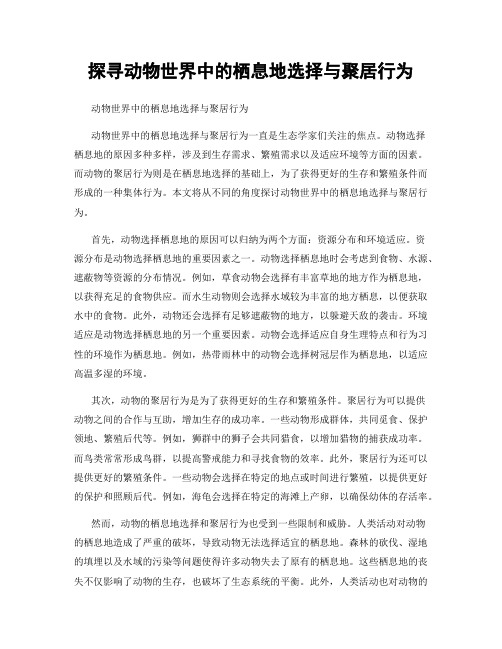
探寻动物世界中的栖息地选择与聚居行为动物世界中的栖息地选择与聚居行为动物世界中的栖息地选择与聚居行为一直是生态学家们关注的焦点。
动物选择栖息地的原因多种多样,涉及到生存需求、繁殖需求以及适应环境等方面的因素。
而动物的聚居行为则是在栖息地选择的基础上,为了获得更好的生存和繁殖条件而形成的一种集体行为。
本文将从不同的角度探讨动物世界中的栖息地选择与聚居行为。
首先,动物选择栖息地的原因可以归纳为两个方面:资源分布和环境适应。
资源分布是动物选择栖息地的重要因素之一。
动物选择栖息地时会考虑到食物、水源、遮蔽物等资源的分布情况。
例如,草食动物会选择有丰富草地的地方作为栖息地,以获得充足的食物供应。
而水生动物则会选择水域较为丰富的地方栖息,以便获取水中的食物。
此外,动物还会选择有足够遮蔽物的地方,以躲避天敌的袭击。
环境适应是动物选择栖息地的另一个重要因素。
动物会选择适应自身生理特点和行为习性的环境作为栖息地。
例如,热带雨林中的动物会选择树冠层作为栖息地,以适应高温多湿的环境。
其次,动物的聚居行为是为了获得更好的生存和繁殖条件。
聚居行为可以提供动物之间的合作与互助,增加生存的成功率。
一些动物形成群体,共同觅食、保护领地、繁殖后代等。
例如,狮群中的狮子会共同猎食,以增加猎物的捕获成功率。
而鸟类常常形成鸟群,以提高警戒能力和寻找食物的效率。
此外,聚居行为还可以提供更好的繁殖条件。
一些动物会选择在特定的地点或时间进行繁殖,以提供更好的保护和照顾后代。
例如,海龟会选择在特定的海滩上产卵,以确保幼体的存活率。
然而,动物的栖息地选择和聚居行为也受到一些限制和威胁。
人类活动对动物的栖息地造成了严重的破坏,导致动物无法选择适宜的栖息地。
森林的砍伐、湿地的填埋以及水域的污染等问题使得许多动物失去了原有的栖息地。
这些栖息地的丧失不仅影响了动物的生存,也破坏了生态系统的平衡。
此外,人类活动也对动物的聚居行为造成了干扰。
城市化进程中的建设活动、旅游业的发展等都对动物的聚居地造成了干扰和破坏。
分析鸟类的栖息地选择和生态位分化

种间竞争
不同鸟类之间会争夺有限的食物 资源和栖息空间,导致生态位分 化和栖息地选择的差异。竞争能 力强的鸟类可能占据更有利的生
态位和栖息地。
人类活动
城市化、农业开发、森林砍伐等 人类活动会改变或破坏鸟类的栖 息环境,从而影响其栖息地选择
和生态位分化。
针对影响因素提出保护策略建议
保护和恢复生态环
分析鸟类的栖息地 选择和生态位分化
汇报人:XX 2024-01-15
目 录
• 鸟类栖息地选择概述 • 生态位分化理论及在鸟类中应用 • 不同类型鸟类栖息地选择特点分析 • 同一区域内不同鸟类生态位分化实例研究 • 影响因素探讨与保护策略建议
01
鸟类栖息地选择概述
栖息地定义与类型
栖息地定义
指鸟类生活和繁殖的地理环境, 包括各种生态系统和生态位。
THANK YOU
感谢观看
未来研究方向展望
深入研究生态环境对鸟类栖息地选择和生态位分化的影响机制,揭示不同鸟类对环 境变化的响应和适应策略。
加强鸟类种间竞争和共生关系的研究,探讨竞争和共生在鸟类生态位分化和栖息地 选择中的作用。
关注全球气候变化对鸟类栖息地选择和生态位分化的影响,预测未来气候变化对鸟 类生存和繁衍的潜在威胁,并提出相应的应对策略。
食物来源
以昆虫、小鱼、虾蟹、软 体动物等为食,在湿地环 境中可轻松觅食。
繁殖场所
通常在湿地附近的草丛、 树丛或开阔地带筑巢繁殖 。
鸣禽类栖息地选择特点
多样化环境适应
鸣禽类适应性强,可栖息在森林 、灌丛、草原、农田等多种环境
中。
食物来源
以昆虫、水果、种子等为食,不同 种类的鸣禽有不同的食物偏好。
繁殖场所
最大熵(Maxent)模型在物种栖息地研究中的应用

最大熵(Maxent)模型在物种栖息地研究中的应用周海涛;那晓东;臧淑英;解瑞峰【期刊名称】《环境科学与管理》【年(卷),期】2016(041)003【摘要】最大熵(Maxent)模型是以生态位理论为基础的新兴研究领域,它通过有限的物种分布点数据及其相关的环境信息组成训练样本,利用基于数据驱动的机器学习理论分析推算出物种的生态需求,然后将运算结果投射至不同的时间和空间中预测物种的潜在分布和实际分布.近年来,该模型在生态学和生物多样性保护等研究中越发重要,文章介绍了Maxent模型的基本原理,从物种栖息地需求分析、气候变化对物种分布的影响、物种入侵监测以及自然保护区的选择和规划设计等方面阐述Maxent模型在物种栖息地研究中的应用.【总页数】3页(P149-151)【作者】周海涛;那晓东;臧淑英;解瑞峰【作者单位】黑龙江省普通高等学校地理环境遥感监测重点实验室哈尔滨师范大学,黑龙江哈尔滨150025;黑龙江省普通高等学校地理环境遥感监测重点实验室哈尔滨师范大学,黑龙江哈尔滨150025;黑龙江省普通高等学校地理环境遥感监测重点实验室哈尔滨师范大学,黑龙江哈尔滨150025;黑龙江省普通高等学校地理环境遥感监测重点实验室哈尔滨师范大学,黑龙江哈尔滨150025【正文语种】中文【中图分类】X171.1【相关文献】1.MAXENT最大熵模型在预测物种潜在分布范围方面的应用 [J], 张路2.最大熵理论Maxent模型在林业中的应用 [J], 涂正彬;戴强;张文3.优化后最大熵模型在模拟驼鹿适宜栖息地分布中的应用 [J], 于沿泽; 张明海; 杜海荣; 李倩; 张立博; 穆文静4.基于MaxEnt模型的褐马鸡西部种群适宜栖息地研究 [J], 李宏群; 牛常会; 韩培士; 刘晓莉; 符勇耀5.最大熵(MaxEnt)模型在鸟类多样性保护中的应用 [J], 李艳;卢欣因版权原因,仅展示原文概要,查看原文内容请购买。
大熊猫栖息地空间观测技术与方法

一、概述大熊猫是我国特有的珍稀物种,被誉为我国的国宝。
然而,由于栖息地破碎化、人类活动干扰等因素的影响,大熊猫的生存环境受到了威胁。
研究大熊猫栖息地空间的观测技术与方法具有重要意义,能够为大熊猫的保护和栖息地管理提供重要支持。
二、栖息地空间观测技术1. 遥感技术:利用卫星遥感数据进行大熊猫栖息地的监测和分析,可以获取大范围、高分辨率的地理信息数据,为栖息地研究提供丰富的空间数据。
2. GPS定位技术:通过在大熊猫身上植入GPS追踪器,实现对大熊猫活动范围、活动路径等信息的实时获取,为栖息地空间的观测提供了精准的数据支持。
3. 空间遥感技术:利用卫星、飞艇等载具进行大熊猫栖息地的空中摄影和监测,能够获取多角度、高精度的栖息地空间信息,为栖息地空间观测提供了全方位的数据支持。
三、栖息地空间观测方法1. 野外调查法:通过实地野外调查,获取大熊猫栖息地的地理空间信息、植被生长情况等数据,为栖息地空间观测提供了直接的实证数据。
2. 生态学模型法:利用生态学模型对大熊猫栖息地的空间分布、适宜性等进行模拟和分析,为栖息地空间观测提供了定量化的支持。
3. 遥感影像解译法:通过对遥感影像进行解译和分析,获取大熊猫栖息地的空间位置、面积大小等信息,为栖息地空间观测提供了可视化的数据支持。
四、技术与方法的应用1. 大熊猫保护管理:栖息地空间观测技术与方法的应用,能够为大熊猫的保护管理提供科学依据,指导相关部门进行栖息地保护、恢复和规划。
2. 生态环境监测:栖息地空间观测技术与方法的应用,能够为生态环境监测提供空间数据支持,为生态环境保护和管理提供科学依据。
3. 科学研究与教育宣传:栖息地空间观测技术与方法的应用,为科学研究和教育宣传提供了丰富的数据支持,促进大熊猫保护和栖息地管理的深入发展。
五、总结与展望大熊猫栖息地空间观测技术与方法的研究与应用,为大熊猫的保护和栖息地管理提供了重要的支持。
未来,随着科技的不断进步和创新,我们相信在大熊猫保护事业中,栖息地空间观测技术与方法将发挥越来越重要的作用,为大熊猫的生存环境提供更加科学、有效的保障。
invest模型生境质量公式
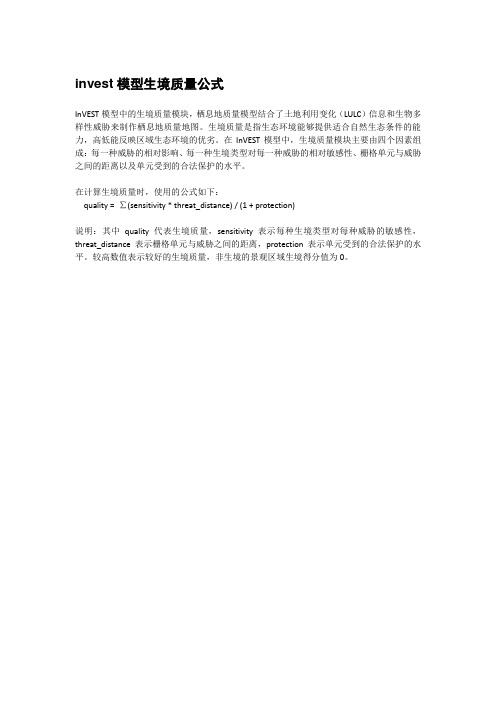
invest模型生境质量公式
InVEST模型中的生境质量模块,栖息地质量模型结合了土地利用变化(LULC)信息和生物多样性威胁来制作栖息地质量地图。
生境质量是指生态环境能够提供适合自然生态条件的能力,高低能反映区域生态环境的优劣。
在InVEST模型中,生境质量模块主要由四个因素组成:每一种威胁的相对影响、每一种生境类型对每一种威胁的相对敏感性、栅格单元与威胁之间的距离以及单元受到的合法保护的水平。
在计算生境质量时,使用的公式如下:
quality = ∑(sensitivity * threat_distance) / (1 + protection)
说明:其中quality代表生境质量,sensitivity表示每种生境类型对每种威胁的敏感性,threat_distance表示栅格单元与威胁之间的距离,protection表示单元受到的合法保护的水平。
较高数值表示较好的生境质量,非生境的景观区域生境得分值为0。
动物的栖息地和栖息适应策略

动物通过学习来适应新环境,提 高生存和繁殖成功率。
动物通过社群行为来共同适应栖 息地环境,如群体防御、互助捕 食等。
动物通过进化来适应栖息地环境, 形成各种适应性特征和器官。
动物通过调整身体机能来适应不同 的栖息环境,例如体温调节、呼吸 适应等。
动物通过进化发展出特殊的器官或 组织来适应栖息地的特殊环境条件, 例如鱼类适应水生环境的鳃和鳍。
前景:通过科学的方法和持续的努 力,动物栖息地可以得到恢复和重 建,为动物提供更好的生存环境
措施:采取有效的保护措施,如生 态修复、植被恢复等,可以促进动 物栖息地的恢复与重建
意义:动物栖息地的恢复与重建对 于保护生物多样性、维护生态平衡 具有重要意义
汇报人:XX
动物栖息地的 选择受到竞争 和合作的影响。
竞争激烈的栖 息地可能导致 动物进化出特 殊的适应策略。
合作行为在动物 栖息地选择中也 有所体现,例如 群居动物共同寻 找适合的栖息地。
竞争与合作在动 物栖息地选择中 起着相互作用, 共同影响动物的 生存和繁衍。
01
0 2
03
04
动物栖息适应策略
动物通过进化,形成与栖息地环境相适应的形态特征,以更好地适应生存环境。
主要栖息地。
空中栖息地:包括 天空和悬崖等,是 鸟类和某些哺乳动 物的主要栖息地。
洞穴栖息地:包括 天然洞穴和人工洞 穴等,是某些动物 如蝙蝠、蛇等的栖
息地。
添加标题
添加标题
添加标题
添加标题
定义:水域栖息地 是指动物在水中或 水域附近的生态环 境,包括河流、湖
泊、海洋等。
添加标题
动物种类:水域栖 息地常见的动物种 类包括鱼类、两栖 动物、爬行动物、
托福阅读habitat selection
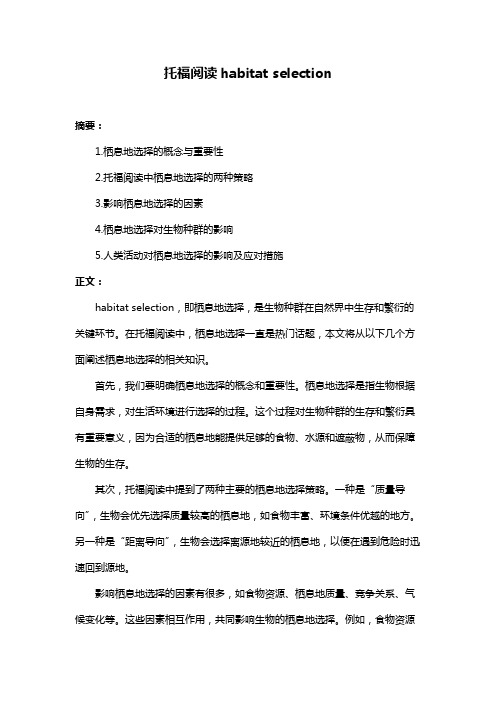
托福阅读habitat selection摘要:1.栖息地选择的概念与重要性2.托福阅读中栖息地选择的两种策略3.影响栖息地选择的因素4.栖息地选择对生物种群的影响5.人类活动对栖息地选择的影响及应对措施正文:habitat selection,即栖息地选择,是生物种群在自然界中生存和繁衍的关键环节。
在托福阅读中,栖息地选择一直是热门话题,本文将从以下几个方面阐述栖息地选择的相关知识。
首先,我们要明确栖息地选择的概念和重要性。
栖息地选择是指生物根据自身需求,对生活环境进行选择的过程。
这个过程对生物种群的生存和繁衍具有重要意义,因为合适的栖息地能提供足够的食物、水源和遮蔽物,从而保障生物的生存。
其次,托福阅读中提到了两种主要的栖息地选择策略。
一种是“质量导向”,生物会优先选择质量较高的栖息地,如食物丰富、环境条件优越的地方。
另一种是“距离导向”,生物会选择离源地较近的栖息地,以便在遇到危险时迅速回到源地。
影响栖息地选择的因素有很多,如食物资源、栖息地质量、竞争关系、气候变化等。
这些因素相互作用,共同影响生物的栖息地选择。
例如,食物资源丰富的地区往往能吸引更多生物种群,而栖息地质量差的地区则可能导致生物种群减少。
栖息地选择对生物种群的影响主要体现在生存和繁衍方面。
合适的栖息地能保障生物的基本需求,有利于种群的繁衍。
反之,不良的栖息地可能导致生物种群衰退甚至灭绝。
因此,栖息地选择是生物种群在自然界中生存的关键。
然而,人类活动对栖息地选择产生了很大影响。
人类过度开发、污染和破坏生态环境,导致许多生物丧失了原有的栖息地。
为了保护生物多样性和生态平衡,我们应采取措施减轻人类活动对生物栖息地的影响。
例如,加强环境保护、实施生态修复、划定自然保护区等。
总之,栖息地选择是生物种群生存和繁衍的基础,受到多种因素的影响。
栖息地选择的理论与模型
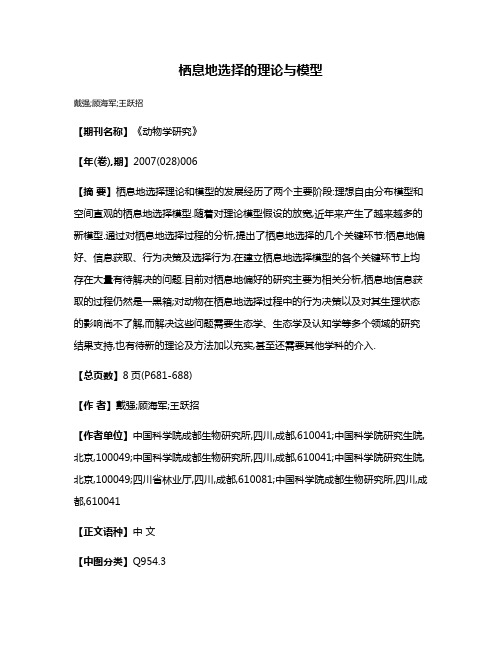
栖息地选择的理论与模型戴强;顾海军;王跃招【期刊名称】《动物学研究》【年(卷),期】2007(028)006【摘要】栖息地选择理论和模型的发展经历了两个主要阶段:理想自由分布模型和空间直观的栖息地选择模型.随着对理论模型假设的放宽,近年来产生了越来越多的新模型.通过对栖息地选择过程的分析,提出了栖息地选择的几个关键环节:栖息地偏好、信息获取、行为决策及选择行为.在建立栖息地选择模型的各个关键环节上均存在大量有待解决的问题.目前对栖息地偏好的研究主要为相关分析,栖息地信息获取的过程仍然是一黑箱;对动物在栖息地选择过程中的行为决策以及对其生理状态的影响尚不了解,而解决这些问题需要生态学、生态学及认知学等多个领域的研究结果支持,也有待新的理论及方法加以充实,甚至还需要其他学科的介入.【总页数】8页(P681-688)【作者】戴强;顾海军;王跃招【作者单位】中国科学院成都生物研究所,四川,成都,610041;中国科学院研究生院,北京,100049;中国科学院成都生物研究所,四川,成都,610041;中国科学院研究生院,北京,100049;四川省林业厅,四川,成都,610081;中国科学院成都生物研究所,四川,成都,610041【正文语种】中文【中图分类】Q954.3【相关文献】1.线性代数的RMI模型理论——向量坐标理论的RMI模型理论 [J], 窦永平2.理论流行病学的库室模型理论及其应用系列研究Ⅰ:一阶库室模型理论及在催化模型研究中的应用 [J], 孙华斌3.鸟类栖息地选择研究中的一种数学模型 [J], 贾非4.白马鸡冬季群体栖息地选择的经验模型 [J], 贾非;王楠;郑光美5.黑龙江流域白头鹤繁殖栖息地选择模型预测 [J], 黄建;FalkHuettmann;郭玉民因版权原因,仅展示原文概要,查看原文内容请购买。
动物的生命周期与栖息地选择

动物生命周3期与栖息地
的关系
生命周期与栖息地的适应性
生命周期:动 物的生长、发 育、繁殖和死
亡过程
栖息地选择: 动物根据自身 需求和环境条 件选择合适的
生活环境
适应性:动物 在生命周期中 适应栖息地的
变化和挑战
例子:鸟类的 迁徙、鱼类的 洄游、哺乳动
物的冬眠等
栖息地变化对生命周期的影响
栖息地变化可能导致食 物来源减少,影响动物
沙漠:干旱炎热,食物和水源极度匮 乏,适合耐旱动物生存
湿地:湿润温暖,食物和水源丰富, 适合多种动物生存
栖息地特征
食物丰富:充足 的食物来源是动 物选择栖息地的 重要因素
水源充足:水 是生命之源, 动物需要足够 的水源来维持 生存
隐蔽性:动物需 要躲避天敌和恶 劣天气,因此会 选择具有隐蔽性 的栖息地
跨学科合作与交流
跨学科合作: 生物学、生态 学、地理学等 多学科合作, 共同研究动物 的生命周期与 栖息地选择
交流平台:建 立学术交流平 台,分享研究 成果,促进学 科间的交流与 合作
合作模式:建 立长期稳定的 合作模式,共 同开展研究项 目,提高研究 效率和质量
展望未来:期 待更多的跨学 科合作与交流, 推动动物研究 领域的发展与 创新
命周期和栖息地。
保护区的设立与管理
设立目的:保护 濒危物种和生态 系统
管理措施:限制 人类活动,保护 生态环境
保护区类型:国 家级、省级、市 级等
保护区效益:促 进生态旅游,提 高当地经济收入
生态恢复与重建的实践
生态重建的方法和步骤
生态恢复的定义和意义
生态恢复与重建的成功案 例
生态恢复与重建的挑战和 展望
THANK YOU
- 1、下载文档前请自行甄别文档内容的完整性,平台不提供额外的编辑、内容补充、找答案等附加服务。
- 2、"仅部分预览"的文档,不可在线预览部分如存在完整性等问题,可反馈申请退款(可完整预览的文档不适用该条件!)。
- 3、如文档侵犯您的权益,请联系客服反馈,我们会尽快为您处理(人工客服工作时间:9:00-18:30)。
收稿日期:2007-06-07;修回日期:2007-09-07基金项目:国家自然科学基金资助项目(30470252);中国科学院成都生物研究所知识创新工程领域前沿项目(CIB-2007-LYQY-Q02) *通讯作者:王跃招,E-mail :arcib@ 第一作者简介:戴强(1973-),硕士,主要从事两栖爬行动物生态学研究动 物 学 研 究 2007,Dec. 28(6):681-688 CN 53-1040/Q ISSN 0254-5853 Zoological Research栖息地选择的理论与模型戴 强1,2,顾海军1,2,3,王跃招1,*(1. 中国科学院成都生物研究所,四川 成都 610041;2. 中国科学院研究生院,北京 100049; 3. 四川省林业厅,四川 成都 610081)摘要:栖息地选择理论和模型的发展经历了两个主要阶段:理想自由分布模型和空间直观的栖息地选择模型。
随着对理论模型假设的放宽,近年来产生了越来越多的新模型。
通过对栖息地选择过程的分析,提出了栖息地选择的几个关键环节:栖息地偏好、信息获取、行为决策及选择行为。
在建立栖息地选择模型的各个关键环节上均存在大量有待解决的问题。
目前对栖息地偏好的研究主要为相关分析,栖息地信息获取的过程仍然是一黑箱;对动物在栖息地选择过程中的行为决策以及对其生理状态的影响尚不了解,而解决这些问题需要生态学、生态学及认知学等多个领域的研究结果支持,也有待新的理论及方法加以充实,甚至还需要其他学科的介入。
关键词: 栖息地选择;栖息地选择过程;理论;模型中图分类号:Q954.3 文献标识码:A 文章编号:0254-5853(2007)06-0681-08Theories and Models for Habitat SelectionDAI Qiang 1,2, GU Hai-jun 1,2,3,WANG Yue-zhao 1,*(1. Chengdu Institute of Biology, the Chinese Academy of Sciences, Chengdu 610041; 2. Graduate School of the Chinese Academy ofSciences, Beijing 100049, China; 3. Sichuan Forestry Bureau, Chengdu 610081)Abstract : The theories and models of habitat selection have been developed through two important stages, i.e. ideal-free distribution models and spatially explicit habitat selection models. Various new theories and models were developed with a relaxed hypothesis of, free moving, and negative density-dependency. Key processes of habitat selection were identified as habitat preference, environmental information apperceiving, decision-making and choice behavior. There are still many questions concerning these four key links that require solutions. Habitat preference requires more controlled experimental studies rather than correlation analysis. Environmental information apperceiving needs to be further investigated by looking at behavior and cognitive scientific methods. Understanding decision-making is limited and needs to incorporate other methods of science, such as artificial intelligence. Understanding effects of choice behavior on the physiological condition of animals requires more physiological and ecological research.Key words : Habitat selection; Process; Theory; Model栖息地选择(habitat selection )是生态学研究中经常涉及的问题。
根据Hutto (1985)和Block & Brennan (1993)的定义,栖息地选择是指导个体对栖息地的非随机利用,进而影响个体生存力和适合度等一系列行为反应。
栖息地选择是动物生态学的一个传统研究领域,也是动物生态学众多分支的基础(Johnson, 1980)。
它与种群生态学(Jonzen et al, 2004)、群落生态学(Morris, 1988)等生态学分支有着密切的关系。
同时,栖息地选择研究可为动物保护措施的制定提供重要的直接依据(Caughley, 1994)。
有关栖息地选择的研究很多(Grinnell, 1917; Sexton, 1958; Zhang et al, 1994; Arthur et al, 1996; Bellis et al, 2006),近年来,其理论也有一定的发展(Fretwell & Lucas, 1969; Fretwell, 1972; Morris, 1988, 1990; Arthur et al, 1996; Rhodes et al, 2005)。
但长期以来,有关栖息地选择的理论一直不够系统,由此招致一些批评(Boyce & McDonald, 1999)。
国内有关栖息地选择,尤其是鸟类栖息地选择的研究甚多(Zhang et al, 1994; Gao et al, 1995; Wei et al, 1996; Dai et al, 2005a; Wang et al, 2007),但对栖息682 动 物 学 研 究 28卷地选择理论的研究却非常缺乏。
虽有少量模型研究,但均为相关性的经验模型(Li & Wang, 2000; Jia et al, 2005),而缺少探讨因果机制的理论模型。
本文拟介绍栖息地选择理论的主要发展过程以及其中一些重要的模型,通过分析栖息地选择过程中的关键环节,指出栖息地选择理论及其模型所存在的问题。
1 栖息地选择理论与模型发展栖息地选择的理论经历了两个主要的发展阶段,第一阶段建立了以Isodar 为代表的经典理论,即理想自由分布模型(ideal-free distribution models , IFD )。
这些理论以最优化理论为基础,提出了动物栖息地选择的机制。
第二阶段则是对经典模型假设条件的放宽,使其更符合自然界的真实过程,其代表理论为空间直观的栖息地选择模型(spatially explicit habitat selection model )。
1.1 理想自由分布模型在早期栖息地选择研究中,均通过动物个体丰度与栖息地环境因子之间的关系建立相关性模型(MacArthur & Pianka, 1966)。
在此基础上,基于最优化理论综合密度效应,建立了理想自由分布模型(Fretwell & Lucas, 1969),即假设个体总是选择能使其适合度达到最大的栖息地;当动物密度较低时,所有个体都会选择环境质量最高的栖息地;然而当动物密度增加时,优质栖息地的实际质量会降低,该栖息地中个体的适合度也随之下降,于是部分个体会转向利用质量较差的栖息地,以保持被利用栖息地的实际适合度较大。
这一现象可通过Isodar 方法(Morris, 1987, 1988, 1990)进行分析(图1):栖息地A 和栖息地B 中个体的适合度均随种群大小增大而降低,但是栖息地B 优于栖息地A ,其中的个体适合度也更高,因此个体会首先选择B ;但是随着B 中种群的增大,其中的个体适合度会逐渐降低,直至低于A 中个体能实现的适合度,于是个体又会转而选择栖息地A ,由此栖息地A 和B 的个体适合度总是保持相等,但栖息地B 中种群大小总是大于栖息地A 。
继Isodar 之后,Fretwell (1972)又将个体的等级序位与领域行为加入模型假设,重建了理想等级分布模型(ideal-despotic distribution models )。
理想等级分布模型认为,由于等级序位和领域行为,个体在不同栖息地中实现的适合度不再相等:优势个图1 Isodar model (simulate Morris, 1987) Fig. 1 Isodar 模型示意图(仿Morris, 1987)体占据优质(或者更大面积)栖息地获得更高的适合度,而低等级个体则占据劣质(或者较小面积)栖息地,其实现的适合度较低(Fretwell, 1972)。
在栖息地适合度与动物密度的关系上,Isodar 假设栖息地所能提供的适合度会随着其中动物个体的密度上升而降低,即负密度依赖的适合度分布(negative density-dependent fitness distribution )(Greene & Stamps, 2001)。
但大量证据表明这一假设在有些时候并不适用(Kenward, 1978; Highsmith, 1982; Buckley, 1997; Kuussaari et al, 1998),当动物种群密度太低时,动物的存活率和繁殖率反而有可能会随着种群密度降低而降低,这就是正密度依赖的Allee 效应(Kokko & Sutherland, 2001)。
Allee 效应在动物中是普遍存在的,比如捕食稀释效应(Highsmith, 1982)、协同警戒(Kenward, 1978)、取食易化(Buckley, 1997)以及低密度下配偶寻找的困难(Kuussaari et al, 1998)。
